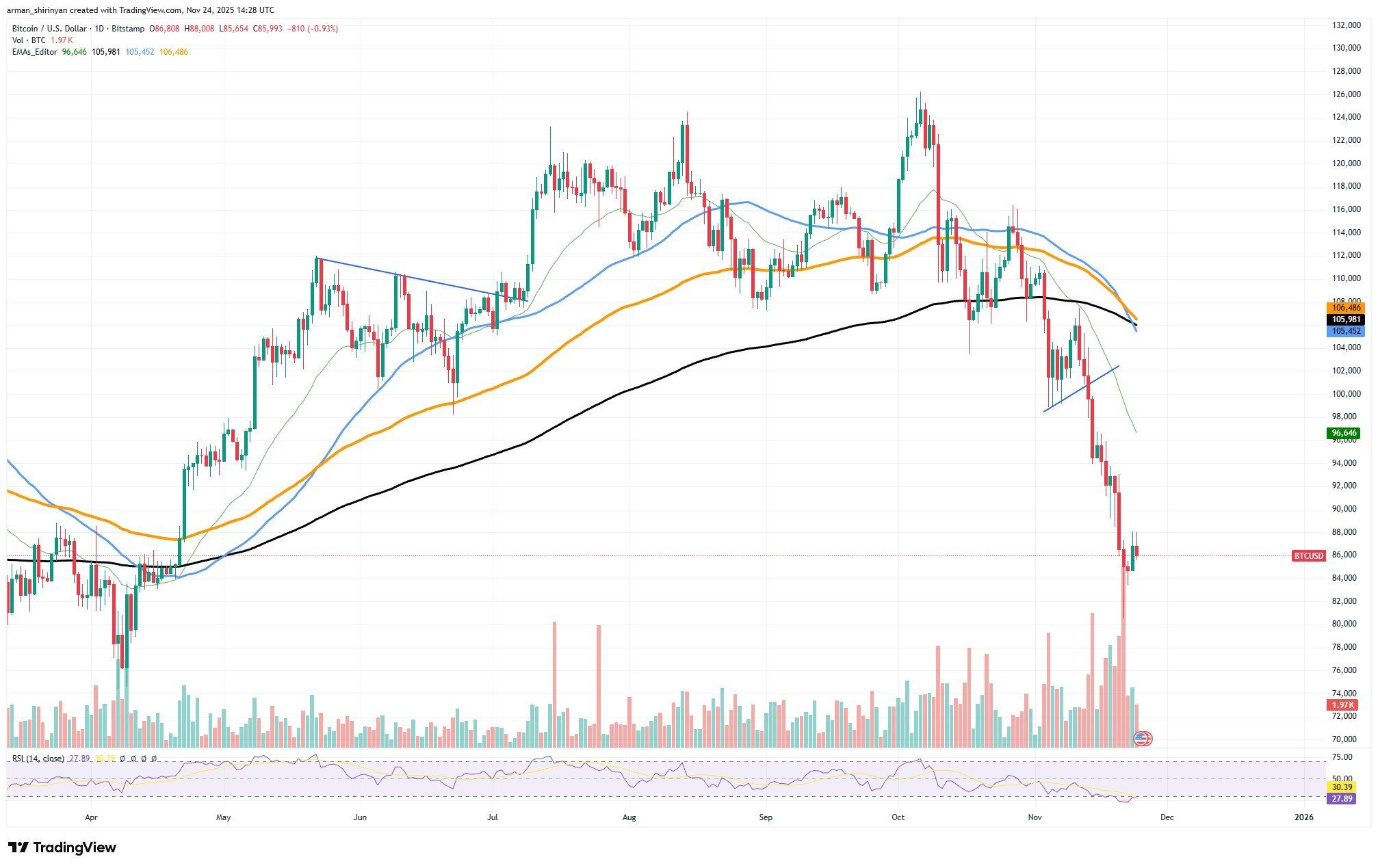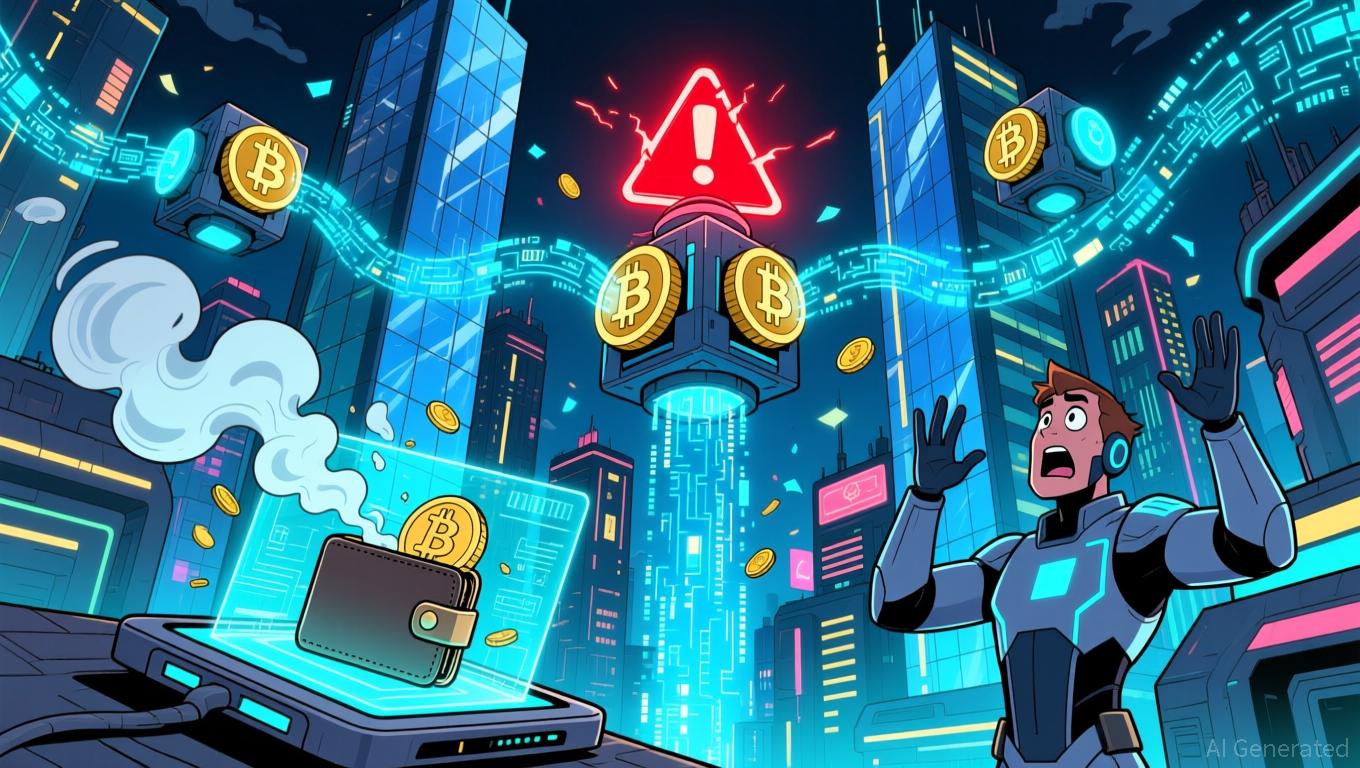Crypto Market Prediction: $1,400,000,000 Bitcoin (BTC) Carnage Over, Ethereum (ETH) Crash Might Not Stop, Shiba Inu (SHIB) Market Collapse Ending
There is not much to hope for from a cryptocurrency when you see how troublesome the whole situation is: Bitcoin is slowing down after multibillion carnage among institutional and retail investors, Ethereum's crash is only gaining momentum and it seems like Shiba Inu is bottoming out.
Bitcoin running out of fuel
It appears that the $1.4 billion liquidation wave of Bitcoin has finally run out. The market printed the first real indication of seller fatigue following a straight-line decline that drove Bitcoin from the $110,000 area into the mid-$80,000s: a sharp recovery off oversold conditions combined with a noticeable slowdown in sell volume.
It usually takes a structural catalyst or a final capitulation flush to reset sentiment when the market gets this stretched. This instance was the latter. The damage is evident on the chart: Bitcoin easily cut through its 20-, 50- and 100-day moving averages. Every attempt at an intraday rally was thwarted by aggressive selling as momentum turned sharply bearish.

Additionally, buyers are intervening for the first time since the decline started, as seen by the long wicks near the bottom. The behavior of Bitcoin in this stabilization zone will determine what happens next. The worst of the chaos is probably over if Bitcoin can stay above the $83,000-$85,000 range. From this point on the price usually moves in the direction of retesting the broken moving averages, which are currently in the $96,000-$105,000 range.
First the 20-day and then the 50-day. This does not imply an instantaneous V-shaped reversal, but when sellers lose control, a grind higher is the normal course. A secondary retest of the lows poses the greatest risk. It becomes a classic bottom structure if the volume is lower and the floor is not broken.
BTC returns to the mid-$70,000s if it breaks. However, it appears that the market has finally released its selling pressure as of right now, and the $1.4 billion purge may have been the capitulation event required to reset the trend.
Ethereum in troublesome position
The one pattern that is beginning to emerge surrounding other significant assets is absent from Ethereum, and this is a problem. Following their capitulation flushes, Bitcoin and Shiba Inu both showed early indications of a rounding bottom, including strong selling, a rebound candle and a curved stabilization, as opposed to a straight rebound. This type of structure occurs when sellers run out of ammunition, and the price starts to bend rather than decline vertically.
However, that curve is absent from Ethereum. Its chart continues to show a steep, nearly linear downslope. Not even leveling. Not a curve. There is no proof that buyers are consciously consuming the supply. That is the initial red flag.
Without hesitation, ETH broke below all of the major moving averages, including the 20-, 50-, 100- and even 200-day, but it has not produced the kind of rebound candle you would anticipate from a true bottoming attempt. ETH did not react with a proper snap-back, in contrast to BTC and SHIB, even though the RSI hit oversold. The bounce is shallow, feeble and far from creating structure.
The price difference from the declining moving averages is the main cause for concern. Instead of curling back toward them, ETH is sliding beneath them. According to trend logic, trapped longs panic-sell into weakness, which frequently results in a second, sharper drop than the first.
Shiba Inu stabilizes
After weeks of sharp declines, Shiba Inu is now showing the first indications of structural stabilization. Although there is not yet a complete reversal structure, the most recent price action is creating a rounding pattern close to the lows, which is sufficient to indicate that the downtrend may be waning.
This shift was accelerated by the oversold RSI. During the most recent decline, SHIB recorded one of its lowest RSI readings of the year; in the past, these readings have led to brief recoveries. The lack of follow-through sales immediately following oversold levels suggests that sellers are beginning to lose motivation. SHIB would have continued to bleed below the $0.0000075 zone if the trend had remained strong; instead, we are witnessing a slight upward curve.
Investors should anticipate a gradual stabilization rather than an instantaneous V-shaped reversal from this point on. Because they depend on sentiment gradually changing from fear to indifference to cautious accumulation, rounding bottoms take time. Only when the price begins to build higher lows on brief time frames — which seems to be happening right now — does that shift become apparent.
The $0.0000075-$0.0000080 support band should be held. The rounding structure gains credibility and indicates a stop to the downtrend if buyers defend this range. SHIB must recover short-term moving averages before the downward trend reverses.
A close above the 20-day creates room for $0.0000092 to $0.0000100. The real resistance is still the long-term declining trendline between $0.0000105 and $0.0000110. SHIB can only transition from stabilization to recovery with a breakout there.
Disclaimer: The content of this article solely reflects the author's opinion and does not represent the platform in any capacity. This article is not intended to serve as a reference for making investment decisions.
You may also like
Bitcoin Updates: Institutional Investments in Bitcoin Face Challenges from DeFi’s Unused Liquidity and Security Issues
- DeFi faces $12B liquidity crisis with 95% capital unused, while Aerodrome Finance suffered DNS hijacking attacks exploiting front-end vulnerabilities. - Bitcoin's price drop below $90,000 triggered $1.425B ETF outflows, contrasting Harvard's $218M Bitcoin/gold investment as inflation hedge. - SEC accelerates crypto ETF approvals as Bitwise's XRP ETF launches, while Spark shifts focus to institutional infrastructure over retail apps. - Market turbulence highlights DeFi's security flaws and liquidity chall

Bitcoin News Update: Japan to Integrate Cryptocurrency with Conventional Finance in 2026 Reserve Requirement
- Japan's FSA will mandate crypto exchanges to hold reserves covering customer losses from hacks or breaches via 2026 legislation. - Reserve amounts will depend on trading volumes and historical risks, with insurance allowed to offset obligations. - The move aligns with global crypto regulations like EU's MiCA and aims to treat digital assets as formal financial products. - While enhancing investor protection for Japan's 12M crypto accounts, critics warn smaller exchanges may struggle with compliance costs

DASH drops 22.6% over the past week following insider stock sales
- DASH fell 22.6% over seven days amid insider sales and tax-related share surrenders. - Executives Adarkar and Sherringham sold shares via SEC-approved 10b5-1 plans through Morgan Stanley . - Directors Fang and Tang surrendered 2,505 shares ($491k total) to cover tax liabilities from equity compensation. - Insider activity reflects routine compliance measures, not bearish sentiment, as DASH approaches earnings release.

Stablecoin Market Exceeds $280B as ECB Warns of Potential Systemic Risks
- Stablecoin market exceeds $280B, driven by regulatory clarity and institutional adoption, capturing 8% of crypto assets. - ECB warns of systemic risks from stablecoin concentration, de-pegging events, and mass redemption "runs" threatening global markets. - USDC overtakes USDT in onchain activity due to regulatory alignment, with Circle's market cap rising 72% YTD to $74B. - ECB calls for global regulatory coordination to address cross-border arbitrage gaps and prevent destabilizing retail deposit shifts

